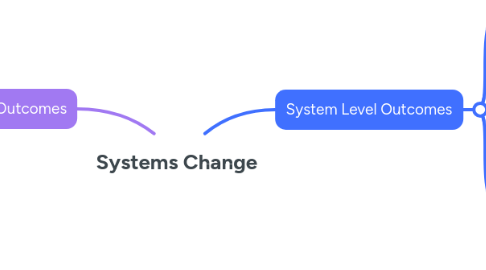
1. PO. People Level Outcomes
1.1. PO.1 Survivors of sexual violence and domestic violence have increased access to post violence care in four provinces
1.1.1. PO.1_100 Percentage of sexual violence survivors who receive immediate care that includes (i) clinical treatment, (ii) forensic evidence collection, (iii) detective services, (iv) trauma containment counselling and (v) referrals for ongoing psychosocial care
1.1.2. PO.1_101 Percentage of DV survivors who gain immediate access to care that includes (i) clinical treatment, (ii) forensic evidence collection, (iii) detective/court services, (iv) trauma containment counselling and (v) referrals for ongoing psychosocial care
1.2. PO.2 Reduction in survivors experience of secondary trauma and victimisation when accessing post sexual violence and DV services
1.2.1. PO.2_102 Percentage of survivors of sexual violence and DV who experience reduced secondary trauma and victimisation when they access care services
2. S. System Level Outcomes
2.1. S1 Regulatory Frameworks
2.1.1. S1.1 Parliament enacts primary legislation that mandates the state to ensure that all survivors all survivors of sexual violence and DV have access to post violence care
2.1.1.1. S1.1_200 Legislation that mandates the state to ensure that all survivors of sexual violence and DV have access to post violence care including (i) clinical treatment, (ii) forensic evidence collection, (iii) detective services, (iv) trauma containment counselling and (v) referrals for ongoing psychosocial care
2.1.2. S1.2. Mitigate the potential risk of legislation or regulations that have a negative impact on the functioning and powers of civil society, such as the VSS Bill and the General Intelligence Laws Amendment Bill
2.1.2.1. S1.2 201 Legislation monitored and interventions by Sakhimpilo and partners
2.2. S2 Financing
2.2.1. S2.1 An analysis of budget priorities, allocations and spending in the relevant programme budgets within the four key government departments responsible for post sexual violence and DV care
2.2.1.1. S2.1_202 Report on budget priorities, allocations and spending in the relevant programme budgets within the four key government departments responsible for post GBV care with recommendations for improved budget alignment and spending and potential for advocacy
2.2.2. S2.2 Improved funding to broaden the funding base to allow for new facilities to be built, increased staffing and capacity building for frontline staff
2.2.2.1. S2.2_203 Suitable models for blended financing recommended or in place
2.3. S3 Service Design
2.3.1. S3.1 Improved and contextually appropriate services allow for easier access for survivors of sexual and domestic violence, including making some services available online, in four provinces
2.3.1.1. S3.1_204 Additional services that allow for easier access for survivors of sexual and domestic violence
2.3.2. S3.2. Survivors receive information about available services and facilities through mobile platform in the aftermath of sexual violence and DV
2.3.2.1. S3.2_205 Number of survivors accessing information in the aftermath of DV and sexual violence
2.3.3. S3.3 A digital system for gathering direct feedback from survivors as service users using their mobile phones and a free internet connection is developed, and data is presented to decision makers
2.3.3.1. S3.3_206 A digital system for gathering direct feedback from survivors
2.3.4. S3.4 Services to survivors improve because there is no longer a siloed approach to prevention and response and between sexual and domestic violence when it comes to post violence care
2.3.4.1. S3.4_207 Post violence care services to survivors take both sexual and domestic violence into account and are sensitive to prevention and response as a continuum
2.4. S4 Service Implementation
2.4.1. S4.1 Increased demand for sexual violence and DV services leads to increased numbers of survivors presenting at health facilities for services
2.4.1.1. S4.1_208 A percentage increase in demand for sexual violence and DV services
2.4.2. S4.2 Frontline staff at health facilities are well trained, supervised and supported and seldom suffer from vicarious trauma, which reduces secondary trauma and victimisation to survivors
2.4.2.1. S4.2_209 Number of frontline staff at health facilities that are well trained, supervised and supported
2.4.3. S4.3 Improved working conditions for frontline staff including making secondary victimisation and vicarious trauma a part of frontline staff performance assessments and training curricula
2.4.3.1. S4.3_210 Improvements in working conditions for frontline staff
2.4.4. S4.3 Frontline staff from different provinces come together regularly to share best practice and engage in collective problem solving for service improvement, strengthen networks and improve the joining up of services to survivors
2.4.4.1. S4.3_211 Government hosts annual and biannual forums intended for learning and sharing
2.5. Structures
2.5.1. S5.1 Strengthened collaboration within the sector through a common agenda and mutually reinforcing outcomes
2.5.1.1. S5.1_212 Levels of intersectoral collaboration between institutions in the sector
2.5.2. S5.2 The feminist movement (or other external formation) is co-developed, bringing in different voices and giving them power over how we engage and what frameworks we use
2.5.2.1. S5.2_213 A functional feminist movement (or other external formation) of individuals, organisations and networks committed to improved services for victims of sexual and domestic violence
2.5.3. S5.3 Feminist leadership is strengthened
2.5.3.1. S5.3_214 Number of leaders who participate in feminist leadership development
2.5.4. S5.4 Empathic, informed, self-aware leadership enables trusting relationships and sustained partnerships within the winning coalition, holding each other accountable
2.5.4.1. S5.4_215 Levels of empathy and self-awareness demonstrated by leaders in the sexual violence and DV sector
2.5.5. S5.5. National and provincial stakeholders mobilised to take part in advocacy activities, including the development of a regulatory framework
2.5.5.1. S5.5_216 Number of NGOs reached and that participate in advocacy activities
3. PS. Partnership Strengthening Outcomes
3.1. PS.1 A container that holds the movement we are building is built and functional
3.1.1. PS.1_300 A container that holds the movement we are building is built and functional
3.2. PS.2 Strengthened capacity in lead organisations
3.2.1. PS.2_301 Capacity to lead and coordinate the initiative and convene the winning coalition
3.3. PS.3 Sakhimpilo's brand identity established and recognised
3.3.1. PS.3_302 Sakhimpilo is established and recognised
3.4. PS.4 Strengthen backbone support for Sakhimpilo
3.4.1. PS.4_303 Functional backbone support for Sakhimpilo
